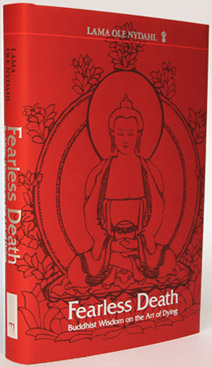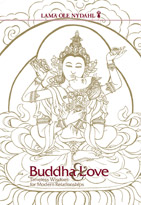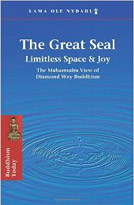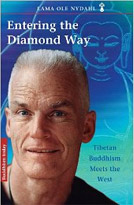Can meditation help us in death?
Everybody knows meditation. The moments in life when one receives a gift, when joy comes out of one’s own power and everything is simply meaningful, are meditation experiences. Without noticing, the ocean of mind comes to rest and one sees clearly; the dust falls from the inner mirror and one understands.
(Fearless Death, page 205)
Any style of meditation naturally induces a calm, relaxed, and somewhat detached state of mind.
Simply focusing and gently holding one’s attention on a single focal point (a neutral object like a candle light, a small statue, or the feeling of the air coming and going at the nostrils) releases anxiety and it can even attenuate one’s perception of pain.
These simple techniques in combination with a wide-open loving attitude for all beings everywhere can produce a welcome relief from the stress induced by hopes, fears, and other compulsive trains of thought related to one’s own imminent death. We all share a basic wish for ultimate happiness and for freedom from any kind of suffering. We can deliberately focus on this universal kinship of being, on the immeasurable richness and unique qualities of all life forms, on the continuous transformations we all experience through life, on the impermanence of all phenomena that appear in the world, play around for a while, and eventually dissolve to make space for ever newer expressions of existence. There is no beginning and no end to this process, we are all part of it, and we can dwell in a warm, immense feeling of loving kindness, fearless compassion, ultimate bliss, and equanimity that embraces all beings. We can also imagine that with each breath we absorb all the negativity of the world, we purify it through our current experience, and we exhale the resulting pure wish for the benefit of all. You are no longer a passive target: thinking of others gives you an important job to do, always and to the best of your ability.
Of course, as with any art form, the best results are possible only with a regular, prolonged training practice and the skillful guidance of an experienced teacher. As the end of one’s life approaches clearly there is not much time available to learn and master advanced meditation techniques.
The Diamond Way (Sanskrit: Vajrayana) Buddhist teachings offer an immense wealth of meditation methods useful in every situation of life and death. Focusing attention on – and identifying with – archetypal wisdom aspects, sounds and visual forms of energy and light, provides a systematic approach to unveil the unborn essence and the timeless awareness present primordially in each of us. All-pervading and vast like space, the direct experience of our own Buddha Nature transcends all limitations and self-centered concerns in life as well as in death. No longer fixated on the illusion of being an impermanent body, we become immune to fear since nothing can harm space; no longer concerned with the illusion of a limited self, we open up to the ecstatic bliss of non-localized awareness; resting effortlessly in the union of space and bliss inseparable, boundless love and freedom pervades meaningfully every experience, even the end of one’s life.
In the beginning it is better to do a guided meditation with a group in order to get to know the practice correctly and to clarify issues. If one wants to follow the Buddhist path, it is necessary to receive oral explanations and transmissions about the meditation from a teacher. In every Diamond Way Center, there are public meditations and introductory evenings.
(Fearless Death, page 206)
The meditation called “Transfer of Consciousness” (Tibetan: Phowa) provides the most powerful method to handle the death experience. At the moment of death we can automatically take control of the situation and deliberately transfer our consciousness into a very pleasant mental state called the Pure Lands of Great Bliss (Tibetan: Dewachen). In the Pure Lands state our consciousness is free from all the limitations associated with physical body and illusory ego; so we can learn and mature very rapidly until we consciously decide to be reborn in a specific place and a suitable physical body where we can be again actively useful to beings.
With the guidance of an experienced teacher, anyone can learn to use this method in just a few days of intensive retreat. Lama Ole has been offering 12-13 courses of Phowa every year in various locations around the world. The signs of success are clearly verifiable by each participant at the end of the course; the resulting feeling of fearlessness and joy will stay for one’s entire life and beyond.
Practice effortlessly and enjoy!
(Fearless Death, page 206)







